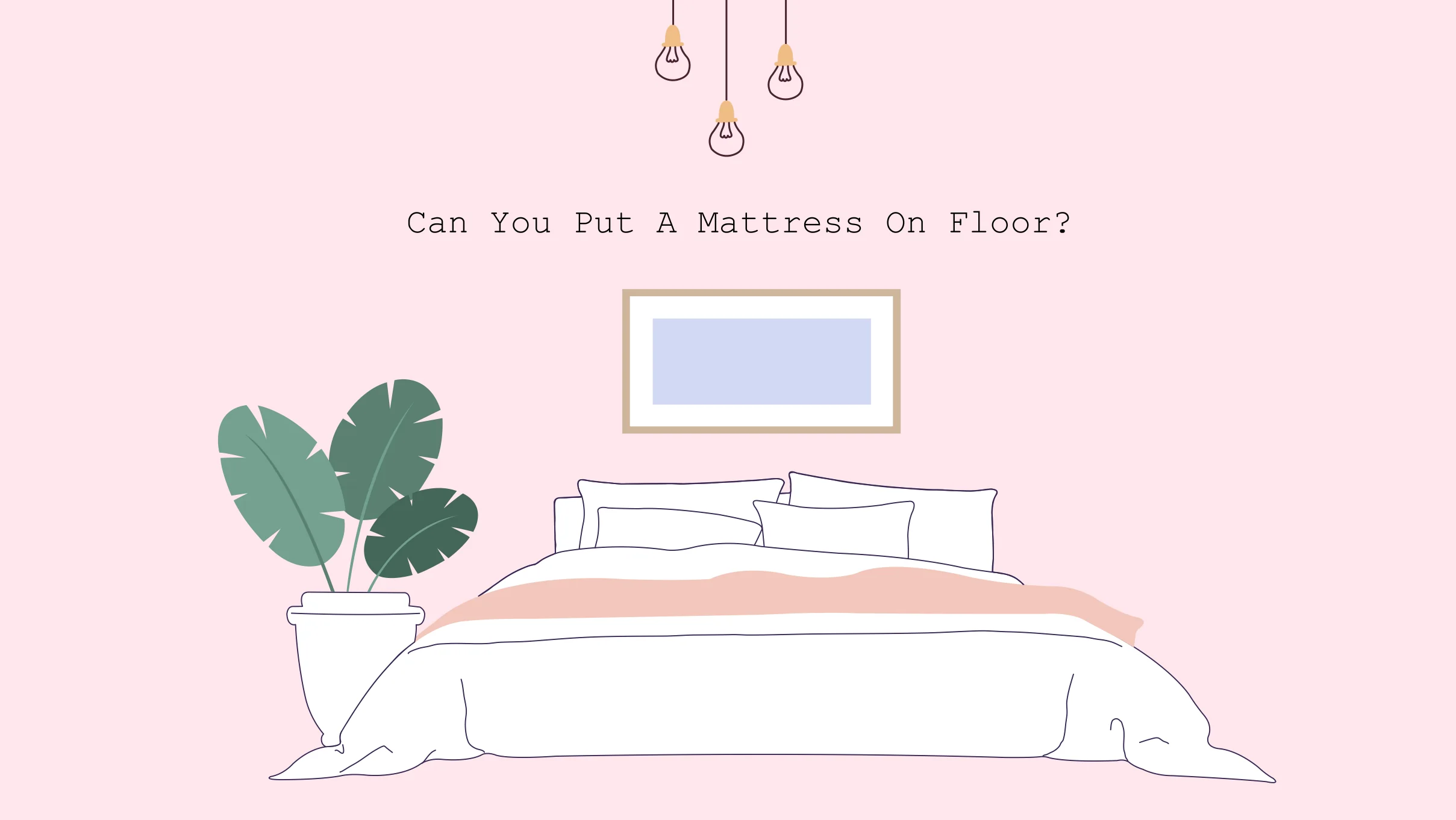Can You Put a Mattress On the Floor?
Written by


Quite often, we notice people putting their mattresses on the floor, but the question is whether they should be put on the floor or not? Even though it is undoubtedly an economical and healthy option, you should not be put on the floor. Most of the mattresses are designed to be put on the bed frame and putting them on the floor can damage it. Check this article to understand the pros and cons of placing a mattress on the floor.
Pros of Putting Mattress on the Floor
Placing a mattress on the floor may be advantageous for several reasons, including cost-effectiveness and numerous health benefits. So let us check the benefits of moving a mattress on the floor.
1. Reduced Back Pain
Putting your mattress directly on the floor might reduce back pain by maintaining a neutral spine, neck, and good posture. This is because putting your mattress directly on the floor will feel firmer and might alleviate back discomfort and maintain a straight spine throughout the night. Additionally, sleeping on the floor may also provide relief from sciatica and a decreased likelihood of experiencing scoliosis.
2. Enhances Blood Circulation
When you place a mattress on the floor, it becomes firmer, and resting on a firm mattress will distribute your body weight properly. Consequently, your muscles and tissues will improve circulation throughout the night due to reduced strain on pressure points. Further, healthy blood circulation promotes the correct functioning of the primary organs, protects against illness, and enhances muscular recovery.
3. Economical
Facing a money crunch? There is no need to invest in a bed frame, box spring, or mattress base. You can choose to focus your money on a comfortable mattress while cutting down on other expenses. Hence, sleeping with your mattress on the floor is an economical option.
4. Takes Up Less Space
Bed frames are sometimes bigger than the original mattress dimensions and take up a lot of space. Hence, placing your mattress on the floor also creates the sense of higher ceilings and larger space.
In fact, transferring a mattress from one place to another can be considered much easier than the bed frame. This way, you can save up quite some amount that would have otherwise incurred on the packers and movers.
Cons of Putting Mattress on the Floor
There are possible disadvantages to sleeping on the floor. So if you are considering putting your mattress on the floor, look at the cons before finalising your decision.
1. Prone to Dust and Mites
You might have noticed that dust usually accumulates on the floor. And sleeping so close to the floor might make you prone to dust allergies if your floor lacks frequent cleaning and dusting. From bugs, and mites, to other dangerous creatures like spiders, and wasps, the moisture in your mattress will invite them all. So, this not just disrupts sleep but may also be harmful to your health.
2. Promotes Mould and Mildew Growth
Box springs and slatted bottoms provide enough ventilation and keep your mattress dry. So whenever you put the mattress on the floor, there is a restriction in ventilation, leading to restless sleep and night sweat. Mould and mildew may form as a result of insufficient air circulation and accumulation of moisture from oils and perspiration.
Not only is mould hazardous to living places, but it also emits an unpleasant odour. So this causes allergic responses such as breathing difficulties and itching skin.
3. Trouble Getting up From Bed
If you experience mobility difficulties, like arthritis or chronic pain, or are old, using a bed close to the floor might be challenging. You would have to squat to get out of the bed, which may be too unpleasant for some. So if you wish to put the mattress on the floor, use a foundation below the mattress for better height or avoid sleeping on the floor completely.
4. Inconvenient for Side Sleepers
When placed on the floor, mattresses feel naturally stiffer and more supporting, which is ideal for those who want more support. However, those who sleep on their sides may find it challenging to sleep peacefully due to the mattress’s inability to conform to their body shape. As a result, it places pressure on their shoulders and hips.
5. Might Void The Manufacturer’s Warranty
The idea of putting your mattress directly on the floor may invalidate the mattress warranty. Most mattresses are designed to rest on a slatted foundation or box spring, not the floor. The presence of dust, bugs, and mildew on the ground voids mattress warranties. Hence, manufacturers caution against putting the mattress on the floor and sleeping.
Types of Mattresses Can You Put On the Floor
Instead of using the standard mattress on the floor, you can use mattresses specially designed to be placed on the floor. Floor mattresses are often relatively thin, measuring between 3 and 6 inches, while a standard mattress measures between 10 and 14 inches. In general, they are less expensive than traditional mattresses. However, they serve better as a temporary sleeping option rather than a permanent bed.
The following are the most prevalent floor mattress type:
- Rollup mattresses are lightweight and portable ones that can be rolled up like a sleeping bag.
- Folding mattresses are thin mattresses that you may fold into compact mats for travelling.
- Air mattresses are inflatable mattresses that may be inflated manually or with electric pumps. They are small and straightforward to store once deflated.
However, these mattresses don’t provide the same support as a regular mattress; over time, they can put pressure on your joints.
Type of Mattresses You Can not Put on the Floor
Despite your wish to sleep with your mattress on the floor, some mattresses are not designed for it.
Polyurethane and memory foam mattresses are not conceived to be placed on the floor. Since they are porous materials, they are more susceptible to growing mildew and attracting germs when placed on the floor. On another note, airflow is a primary condition in mattresses for preserving durability – that becomes impossible when compressed against the floor.
Tips for Placing your Mattress on the Floor
Apart from regular cleaning, there are other things to note when placing the mattress on the floor. Mattresses like a box spring or slatted platform are more susceptible to damage without support. Hence, taking additional steps may increase the life of your mattress. So these tips are as follows:
1. Regularly Air Out the Mattress
Perhaps once each week, you must air out your mattress. Rotate your mattress every 6 months. Additionally, if you reside in a humid environment, you should attempt to air out the mattress every few days.
2. Keep the Floor Underneath your Mattress Clean
Always clean, sweep, and disinfect the space under and around your mattress to avoid dirt accumulation. Maintaining a clean floor prevents insects and dust from infesting your sleeping area. Always ensure that the floor is entirely dry before putting the mattress on it. Your mattress is susceptible to mould growth on a wet or slightly moist surface.
3. Check Your Mattress Guarantee
In some circumstances, using a mattress on the floor may void the warranty. Typically, companies have precise bed assembly instructions that one must follow to retain the guarantee. Before setting up your bed on the floor, you should thoroughly review your mattress’s guarantee.
4. Put Mattress on Finished Flooring
Before you put your mattress on the floor, you need to know what type of floor is suitable. Consider putting your mattress on a tile, hardwood, tatami (thick Japanese mats ), or synthetic rug. As these materials don’t retain moisture, they won’t let mould thrive and keep your mattress mould-free.
5. Placing a Barrier Between the Mattress and Floor
Placing a barrier like a blanket, foam pad, or cardboard between the floor and the mattress might be beneficial in preventing it from premature wear and preserving its quality. Further, a barrier keeps the mattress clean and improves its insulation.
6. Get a Mattress Protector
Use a mattress protector, even if it doesn’t have a bed frame. It’s vital to safeguard your mattress from bacteria and floor dust. Further, it protects the mattress on the floor against sweat, grime, stains, and germs, keeping it durable for a long-time.
Conclusion
Although sleeping on the floor may not be suitable for everyone. It could be an excellent choice for some, particularly those with back discomfort. However, if you wish to use your mattress on the floor, you must take the required measures to protect yourself and your mattress. Always verify your mattress’s warranty before placing it on the floor since doing so might void it.
FAQs
Can you put a box spring mattress on the floor?
Yes, putting a box spring on the floor is fine. A box spring mattress would provide better support for you and is easily ventilated; hence the chance of mould growth is less.
What goes under the mattress?
It’s recommended to buy a mattress protector for your mattress on the floor to protect it from moisture, mould and dust. If you can’t buy one, you can use a barrier between the floor and your mattresses, like a rug or a foam mat. Even a piece of cardboard will do the job just fine.
How to keep your mattress from sliding?
A mattress on the floor usually slides due to a lack of friction. To prevent slipping, putting something under the mattress like a rubber pad, a foam mat, or a rug will also do the job.
What is a low-profile bed frame?
A low-profile bed frame is low in height and closer to the ground; as it’s low in height, you lose features like storage drawers under the bed. A low-profile bed frame is generally preferred by people that are either short in height or like sleeping close to the ground.
How high should your bed be on the floor?
The ideal bed height differs by individual, but the average height is 25 inches. One may find the ideal bed height by measuring from the ground to the mattress top.
people like this article
Written by



